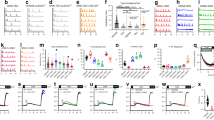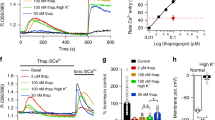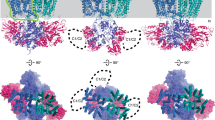Abstract
Transcriptional activity inside the nucleus of eukaryotic cells is regulated by ions such as calcium that need to be transported across the nuclear membrane. Here we show that an ion channel spanning the nuclear envelope between the cytoplasm and the nucleus could be regulated by an ATP-binding receptor of the P2X7 subtype. Activation of this nuclear P2X7 receptor by ATP in the cytoplasm may be a mechanism by which cellular activity can be coupled to changes in gene expression.
Similar content being viewed by others
Main
P2X7 receptors are members of a family of ATP-binding receptors that are permeable to calcium. Originally thought to be absent from neurons1, the P2X7-receptor subunit P2X7R has been shown to be targeted to excitatory but not inhibitory terminals, and yet it is absent from plasma membranes of the cell body2,3.
To determine whether inhibitory neurons also express the receptor, we used in situ hybridization of the rat hippocampus to detect messenger RNA encoding P2X7R. A positive signal was seen in the cytoplasm of all neurons in the cell-body layer3, 90% of which are excitatory cells4. In contrast to the localization of the P2X7R protein to the terminals of only excitatory neurons, however, P2X7R mRNA was also present in cells containing immunoreactivity for the potassium-channel subunit Kv3.1b, which identifies a subset of inhibitory neurons in the hippocampus5 (Fig. 1a, b).
a, Messenger RNA encoding P2X7R (visualized with alkaline phosphatase2) is present in the cytoplasm of all neurons in the hippocampus, and is shown in one neuron (nu, nucleus) adjacent to the cell-body layer; b, this neuron is identified as inhibitory by the presence of predominantly membrane-bound red Kv3.1b immunofluorescence (antibody against the K+-channel subunit Kv3.1b from Alomone Labs). c, d, Localization by light microscopy of P2X7R protein: 'intracellular' (c) and 'extracellular' (d) epitopes are seen adjacent to the nuclear membrane (arrows) in all neurons in the cell-body layer. e, f, Immuno-electron microscopy of P2X7R, seen here spanning the nuclear envelope, with e, its 'intracellular' portion adjacent to the nuclear side of the nuclear envelope (arrows), and f, its 'extracellular' portion facing the cytoplasm (cyt; arrows). Scale bars: a, b, 5 µm; c, d, 50 µm; e, f, 0.5 µm.
The mismatch between the expression of P2X7R mRNA and its protein in inhibitory neurons was explained when we used different antisera to stain the intra cellular (specific to amino-acid residues 576–595; 1:1,000 dilution; refs 2, 6) and extracellular (specific to amino acids 60–323; 1:100 dilution; ref. 6) portions of P2X7R and found staining adjacent to the nuclear envelope in 100% of hippocampal neurons (Fig. 1c, d).
The protein must span the nuclear envelope because the antisera against the two different epitopes labelled the cytoplasmic and inner surfaces of the nuclear membrane, respectively, with the ATP-binding site being in the 'extracellular' portion facing the cytoplasm (Fig. 1e, f). This finding still leaves unanswered the question of how P2X7R is transported selectively to the presynaptic terminal in only excitatory neurons but to the nuclear envelope in all neurons.
Insertion of P2X7R into the nuclear envelope is consistent with patch-clamp studies on nuclei showing that ATP binding maintains the open state of non-selective cation channels7 as well as inducing a macroscopic current8. The properties of P2X7Rs correlate with these nuclear channels as they exhibit little or no desensitization9, they are activated by ATP (the 50% effective concentration is about 100 µM (ref. 9), which is well within the 5–10-mM range of cytoplasmic ATP), and they form a large pore upon prolonged activation9 (which may correspond to the ATP-induced macroscopic current in the nuclear membrane8 and the increase in envelope permeability induced by ATP binding7).
Moreover, the ATP-gated nuclear channels7,8 and the P2X7R9 are both permeable to Ca2+ ions, and changes in nuclear Ca2+ concentration are linked to changes in the transcription of several genes implicated in neuronal plasticity (principally by regulating the activity of the transcriptional co-activator protein CBP)10. The presence of P2X7R in the nuclear envelope of phenotypically heterogeneous neurons and of ATP-gated channels in nuclei of diverse cell types (such as Xenopus oocytes and mouse liver cells) therefore has wide implications as it provides a means of regulating nuclear Ca2+ concentration in response to cytoplasmic activity.
References
Collo, G. et al. Neuropharmacology 36, 1277–1283 (1997).
Deuchars, S. A. et al. J. Neurosci. 21, 7143–7152 (2001).
Sperlágh, B. et al. J. Neurochem. 81, 1196–1211 (2002).
Freund, T. F. & Buzsaki, G. Hippocampus 6, 347–470 (1996).
Du, J., Zhang, L., Weiser, M., Rudy, B. & McBain, C. J. J. Neurosci. 16, 506–518 (1996).
Kim, M., Spelta, V., Sim, J., North, R. A. & Surprenant, A. J. Biol. Chem. 276, 23262–23267 (2001).
Mazzanti, M., Innocenti, B. & Rigatelli, M. FASEB J. 8, 231–236 (1994).
Assandri, R. & Mazzanti, M. J. Membr. Biol. 157, 301–309 (1997).
Surprenant, A., Rassendren, F., Kawashima, E., North, R. A. & Buell, G. Science 272, 735–738 (1996).
Bading, H. Eur. J. Biochem. 267, 5280–5283 (2000).
Author information
Authors and Affiliations
Corresponding author
Ethics declarations
Competing interests
The authors declare no competing financial interests.
Rights and permissions
About this article
Cite this article
Atkinson, L., Milligan, C., Buckley, N. et al. An ATP-gated ion channel at the cell nucleus. Nature 420, 42 (2002). https://doi.org/10.1038/420042a
Issue Date:
DOI: https://doi.org/10.1038/420042a
This article is cited by
-
Intracellular expression of purinoceptors
Purinergic Signalling (2015)
-
Purinergic signalling in the gastrointestinal tract and related organs in health and disease
Purinergic Signalling (2014)
-
P2X7 receptors in cerebral ischemia
Neuroscience Bulletin (2013)
-
Molecular and functional properties of P2X receptors—recent progress and persisting challenges
Purinergic Signalling (2012)
-
P2 receptors and neuronal injury
Pflügers Archiv - European Journal of Physiology (2006)
Comments
By submitting a comment you agree to abide by our Terms and Community Guidelines. If you find something abusive or that does not comply with our terms or guidelines please flag it as inappropriate.




